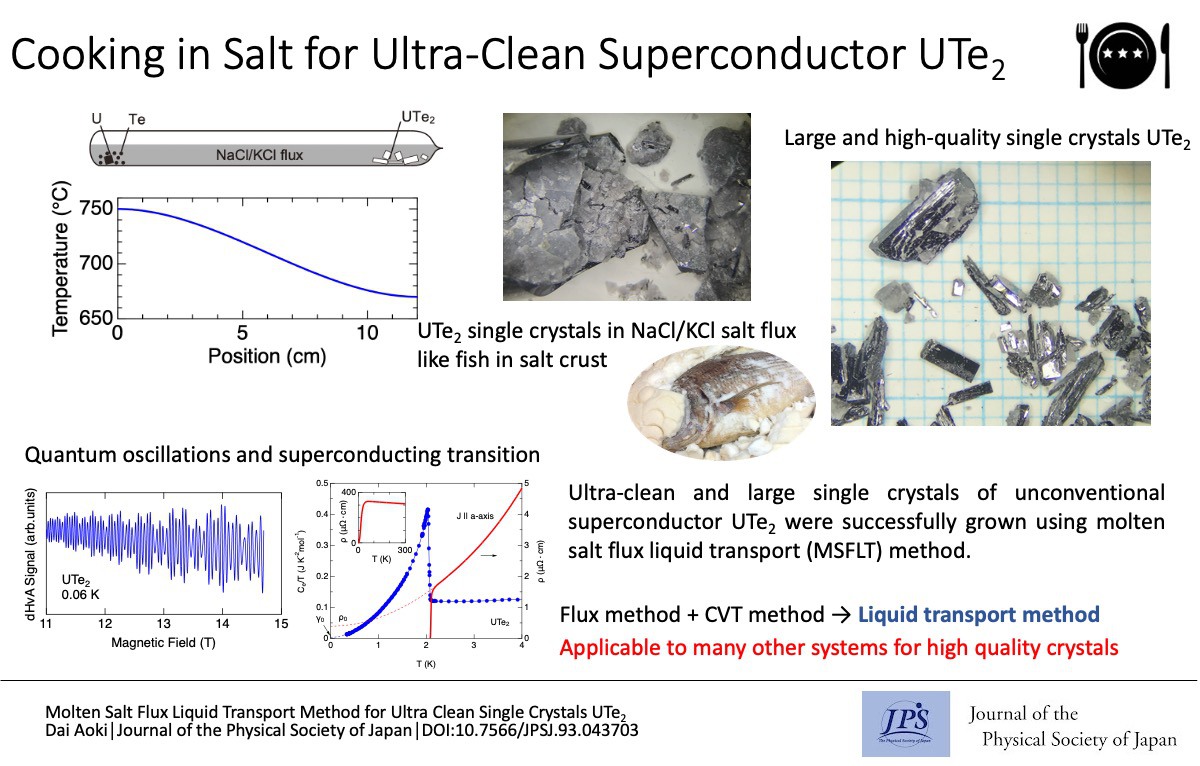Cooking in Salt for Ultra-Clean Superconductor UTe2
© The Physical Society of Japan
This article is on
Molten Salt Flux Liquid Transport Method for Ultra Clean Single Crystals UTe2
J. Phys. Soc. Jpn. 93, 043703 (2024).
A new crystal growth technique, the molten salt flux liquid transport method, was developed to produce high-quality single crystals of spin-triplet superconductor UTe2. This method is promising for exploring the exotic superconductivity of other materials.

UTe2 is among the most intriguing materials in condensed matter physics owing to its unusual superconducting properties. The significant features of UTe2 include its immense field-reentrant superconductivity and the observation of multiple superconducting phases that have been highlighted in the study of superconducting phenomena. These experimental findings align with the spin-triplet superconductivity scenario, in which the superconducting upper critical field surpasses the limit of the critical field for conventional superconductivity. Moreover, spin and orbital degrees of freedom may contribute to the emergence of multiple superconducting phases.
To thoroughly investigate this fascinating material, precise experiments conducted under extreme conditions using high-quality single crystals are essential. This paper introduces a novel approach known as molten salt flux liquid transport (MSFLT) method for growing high-quality single crystals of UTe2. This technique is a hybrid of the molten salt flux (MSF) and chemical vapor transport (CVT) methods . Large, high-quality single crystals were obtained by gradually synthesizing UTe2 single crystals at relatively low temperatures that were maintained throughout the process. These single crystals were buried in the NaCl/KCl salt, akin to fish in a salt crust.
The quality of the single crystals was validated by resistivity and specific heat measurements. The superconducting transition temperature reached 2.1 K for the highest-quality sample, and the residual density of states in the superconducting state approached zero, indicating an ideal superconducting transition. The observation of quantum oscillations, known as the de Haas–van Alphen effect, under extreme conditions (low temperature and high field) clearly suggested that the high-field condition was satisfied for the cyclotron motion of the conduction electrons.
The MSFLT method, also known as the liquid transport method or horizontal flux method, holds promise for broader applications beyond UTe2. This technique can be extended to many other materials for which high-quality single crystals are scarce, opening new avenues for the discovery of exotic superconductors.
Written by D. Aoki
Molten Salt Flux Liquid Transport Method for Ultra Clean Single Crystals UTe2
J. Phys. Soc. Jpn. 93, 043703 (2024).
Share this topic
Fields
Related Articles
-
Microscopic Exploration of Electronic States in Nickelate Superconductors
Magnetic properties in condensed matter
Superconductivity
2024-5-31
The multilayered nickelates, La3Ni2O7 and La4Ni3O10 , were investigated using nuclear magnetic resonance (NMR) at ambient pressure. Metallic electronic states under the density wave order were observed microscopically for both compounds.
-
Single-Crystal Growth of a Cuprate Superconductor with the Highest Critical Temperature
Superconductivity
2024-5-20
Millimeter-sized single crystals of a trilayer cuprate superconductor (Hg,Re)Ba2Ca2Cu3O8+δ that exhibits the highest superconducting transition temperature under ambient pressure, were grown reproducibly and safely.
-
Exploring Electronic States in BEDT-TTF Organic Superconductors
Superconductivity
Electronic transport in condensed matter
Magnetic properties in condensed matter
2024-4-24
This review, published in the Journal of the Physical Society of Japan, provides a comprehensive summary of the electronic states observed in BEDT-TTF type organic superconductors, including metal-insulator transitions, Mottness transitions, non-Fermi liquids, quantum spin liquids, and Bose-Einstein condensation.
-
A New Superconductor Family with Various Magnetic Elements
Superconductivity
Cross-disciplinary physics and related areas of science and technology
Electron states in condensed matter
2023-10-27
A new superconductor family, Sc6MTe2, has been discovered, comprising seven variations with magnetic elements labeled as M. Notably, only a few known superconductor families exist that involve various magnetic elements.
-
Exploring Vortex Dynamics in a Multi-band Superconductor
Superconductivity
2023-8-22
We measured the microwave flux-flow Hall effect in FeSe, where the cancellation of holes and electrons was observed. This is a novel effect of multi-band superconductors.
